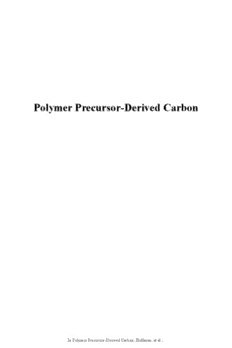Table Of ContentPolymer Precursor-Derived Carbon
In Polymer Precursor-Derived Carbon; Hoffman, et al.;
In Polymer Precursor-Derived Carbon; Hoffman, et al.;
1173
ACS SYMPOSIUM SERIES
Polymer Precursor-Derived Carbon
Amit K. Naskar, Editor
Oak Ridge National Laboratory
Oak Ridge, Tennessee
Wesley P. Hoffman, Editor
Air Force Research Laboratory
Edwards AFB, California
Sponsored by the
ACSDivisionofPolymerChemistry, Inc.
AmericanChemicalSociety,Washington,DC
DistributedinprintbyOxfordUniversityPress
In Polymer Precursor-Derived Carbon; Hoffman, et al.;
LibraryofCongressCataloging-in-PublicationData
Polymerprecursor-derivedcarbon/AmitK.Naskar,editor,OakRidgeNationalLaboratory,
OakRidge,Tennessee,WesleyP.Hoffman,editor,AirForceResearchLaboratory,Edwards
AFB,California;sponsoredbytheACSDivisionofPolymerChemistry,Inc.
pagescm.-- (ACSsymposiumseries;1173)
Includesbibliographicalreferencesandindex.
ISBN978-0-8412-2966-2(alk.paper)
1. Carboncomposites.2. Carbon.3. Polymers. I.Naskar,AmitK.,editor.II.Hoffman,
WesleyP.,editor.III.AmericanChemicalSociety.DivisionofPolymerChemistry.
QD181.C1P582014
546′.681--dc3
2014037321
ThepaperusedinthispublicationmeetstheminimumrequirementsofAmericanNational
Standard for Information Sciences—Permanence of Paper for Printed Library Materials,
ANSIZ39.48n1984.
Copyright©2014AmericanChemicalSociety
DistributedinprintbyOxfordUniversityPress
AllRightsReserved. ReprographiccopyingbeyondthatpermittedbySections107or108
oftheU.S.CopyrightActisallowedforinternaluseonly,providedthataper-chapterfeeof
$40.25plus$0.75perpageispaidtotheCopyrightClearanceCenter,Inc.,222Rosewood
Drive,Danvers,MA01923,USA.Republicationorreproductionforsaleofpagesinthis
bookispermittedonlyunderlicensefromACS.Directtheseandotherpermissionrequests
toACSCopyrightOffice,PublicationsDivision,115516thStreet,N.W.,Washington,DC
20036.
Thecitationoftradenamesand/ornamesofmanufacturersinthispublicationisnottobe
construedasanendorsementorasapprovalbyACSofthecommercialproductsorservices
referenced herein; nor should the mere reference herein to any drawing, specification,
chemicalprocess, orotherdataberegardedasalicenseorasaconveyanceofanyright
or permission to the holder, reader, or any other person or corporation, to manufacture,
reproduce,use,orsellanypatentedinventionorcopyrightedworkthatmayinanywaybe
relatedthereto. Registerednames,trademarks,etc.,usedinthispublication,evenwithout
specificindicationthereof,arenottobeconsideredunprotectedbylaw.
PRINTEDINTHEUNITEDSTATESOFAMERICA
In Polymer Precursor-Derived Carbon; Hoffman, et al.;
Foreword
The ACS Symposium Series was first published in 1974 to provide a
mechanism for publishing symposia quickly in book form. The purpose of
the series is to publish timely, comprehensive books developed from the ACS
sponsoredsymposiabasedoncurrentscientificresearch. Occasionally,booksare
developed from symposia sponsored by other organizations when the topic is of
keeninteresttothechemistryaudience.
Beforeagreeingtopublishabook,theproposedtableofcontentsisreviewed
forappropriateandcomprehensivecoverageandforinteresttotheaudience. Some
papersmaybeexcludedtobetterfocusthebook;othersmaybeaddedtoprovide
comprehensiveness. When appropriate, overview or introductory chapters are
added. Draftsofchaptersarepeer-reviewedpriortofinalacceptanceorrejection,
andmanuscriptsarepreparedincamera-readyformat.
As a rule, only original research papers and original review papers are
included in the volumes. Verbatim reproductions of previous published papers
arenotaccepted.
ACSBooksDepartment
In Polymer Precursor-Derived Carbon; Hoffman, et al.;
Preface
Carbon is essential to life on Earth, and it forms complex molecules with
oxygen, hydrogen, and nitrogen that are ubiquitous in the biosphere. Elemental
carbon has been valued for thousands of years for its use in processing metal
ores. The variety of carbon allotropes as well as the vast variety of carbon’s
architectures, and forms is made possible by its ability to form sp, sp2, and
sp3 electronic orbitals through hybridization. These various architectures and
formscanencompassaverybroadspectrumofproperties,which,inturnenable
a myriad of applications. Traditional methods for synthesizing carbon-based
materials include catalytic vapor growth, hydrothermal processing of colloids,
chemical vapor deposition, as well as pyrolysis of precursors, such as fibers,
bulk monoliths, fuels, and fuel derivatives. Some of these methods follow a
combinatorial optimization approach, which does not necessarily enable the
desiredcontrolofcarbonarchitecture. Thescienceofcontrollingcarbonstructure
with predefined geometries and controlled levels of long-range order from
atypicalchar-formingprecursorshasyettobeestablished.
Over the last two decades there have been significant improvements in
synthesis routes of carbon materials, analytical tools for characterization, and
in the properties of carbon materials. Monolithic or continuous matrix carbon
productsarecommerciallyproducedfrompolymericandpitchcarbonprecursors.
Specialty carbon materials are used for energy applications and reduction in
carbonemission,membraneseparation,energystorage,catalysis,solarutilization,
electronics, and sensing. New generation higher-performance structural carbon
fibershavethepotentialtoenhancevehicleefficiencyandreducegreenhousegas
emissionwhenusedascompositelightweightstructures.
Thisbook,PolymerPrecursor-DerivedCarbon,isbasedonaninternational
symposiumorganizedbytheeditors,alongwithProfessorDennisW.SmithJr. of
UT-Dallas,andheldatthe2013nationalACSmeetinginNewOrleans,Louisiana.
Manyexcitingnewfindingswerereportedinthesymposium,whichwasattended
byresearchersfromacademia,industry,andgovernmentresearchlaboratories.
The editors would like to thank the authors for their timely contributions
to this endeavor, for without their cooperation this undertaking would not have
succeeded. TheeditorswouldalsoliketothankPOLYDivisionoftheAmerican
Chemical Society and Oak Ridge National Laboratory for sponsoring the
symposium. AveryspecialthankyougoestoProfessorDennisSmith, whohas
workedinthisfieldforyears,conceivedtheideaforthissymposium,spearheaded
itsorganization,andworkedtirelesslytowarditssuccess.
xi
In Polymer Precursor-Derived Carbon; Hoffman, et al.;
We are also grateful to the publishing editor and editorial office of the
American Chemical Society for their efforts and professionalism in publishing
this book.
AmitK.Naskar
SeniorR&DStaff&CarbonandCompositesGroupLeader
MaterialsScienceandTechnologyDivision
OakRidgeNationalLaboratory
OakRidge,Tennessee37931-6053
[email protected](e-mail)
WesleyP.Hoffman
PrincipalScientistandGroupLeader
AirForceResearchLaboratory
AFRL/RQRC
10E.SaturnBlvd.
EdwardsAFB,California93524-7680
[email protected](e-mail)
xii
In Polymer Precursor-Derived Carbon; Hoffman, et al.;
Dedication
In memory of Professor James E. McGrath,
whoinspiredustoorganizethisendeavor.
ix
In Polymer Precursor-Derived Carbon; Hoffman, et al.;
Editors’ Biographies
Amit K. Naskar
Dr. AmitK.NaskarisaseniorR&DstaffmemberandleaderoftheCarbon
and Composites group of the Materials Science and Technology Division at
Oak Ridge National Laboratory in Oak Ridge, Tennessee. He has developed
technologies for the conversion of polyolefin into structural carbon materials,
lignin-basedcarbonprecursorsandpolymersforcomposites,andtailoredcarbon
morphology for energy storage applications. He has more than 15 years of
researchexperienceincarbon,polymericfibers,rubbers,plastics,andcomposite
materials.
Wesley P. Hoffman
Dr. WesleyP.HoffmanisaPrincipalScientistandtheGroupLeadoftheHigh
TemperatureComponentsGroupattheAirForceResearchLaboratoryinEdwards
California,whosefocusisrocketpropulsion. Hehasbeenworkinginthefieldof
carbonresearch,principallyintheareasofcarbon–carboncompositesandsurface
characterization,forover40yearsbothattheAirForceResearchLaboratoryand
the Institut de Science des Materiaux de Mulhouse in Mulhouse, France. After
servinginvariouscapacities,heservedthreetermsasChairmanoftheExecutive
CommitteeoftheAmericanCarbonSociety.
©2014AmericanChemicalSociety
In Polymer Precursor-Derived Carbon; Hoffman, et al.;
Chapter 1
Self-Assembly of Polyaromatic Precursors for
1D and 2D Carbon Structures
KatrinWunderlich,1ArminGölzhäuser,2
MarkusKlapper,*,1andKlausMüllen*,1
1MaxPlanckInstituteforPolymerResearch,
Ackermannweg10,55128Mainz,Germany
2FacultyofPhysics,UniversityofBielefeld,33615Bielefeld,Germany
*E-mail: [email protected]
*E-mail: [email protected]
Self-assembly of amphiphiles is used as a tool for structuring
carbonaceous materials in one and two dimensions. The
dynamics of low-molecular weight amphiphiles are combined
with the stability of their high-molecular weight analogues
in order to control the self-assembly of these molecules.
Two concepts for structuring carbon by self-assembly are
presented. Inthefirst,hexaphenylbenzene-polyethyleneglycol
(HPB-PEG)derivativesleadtofiber-likestructuresinaqueous
solution. ThewatercontentinthehydrogelfibersofHPB-PEG
derivatives can be controlled by the substitution pattern of the
amphiphile and by the length of the PEG chains. The fiber
formationisverifiedbylightscatteringandTEM.Inthesecond
concept,homogeneousporouscarbonmembranesareobtained
after electron irradiation and pyrolysis of a thiol-substituted
HPB.Inbothconcepts,amphiphilicity,geometryandsizeofthe
moleculesaredecisiveparametersfortheformationofdefined
structures.
©2014AmericanChemicalSociety
In Polymer Precursor-Derived Carbon; Hoffman, et al.;

